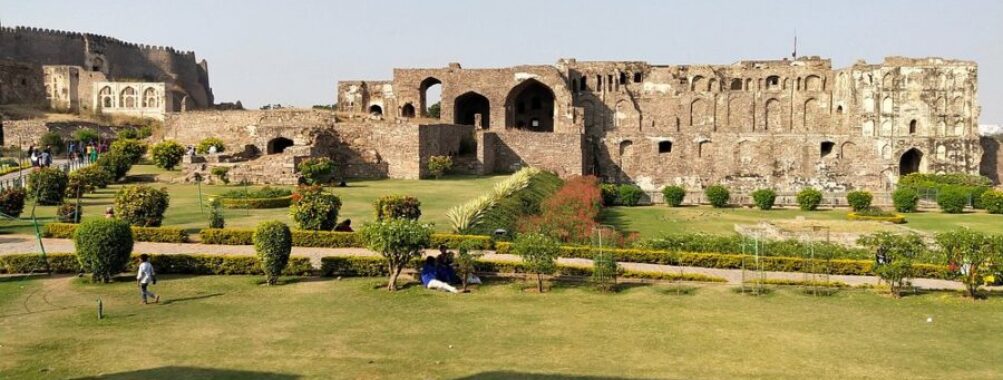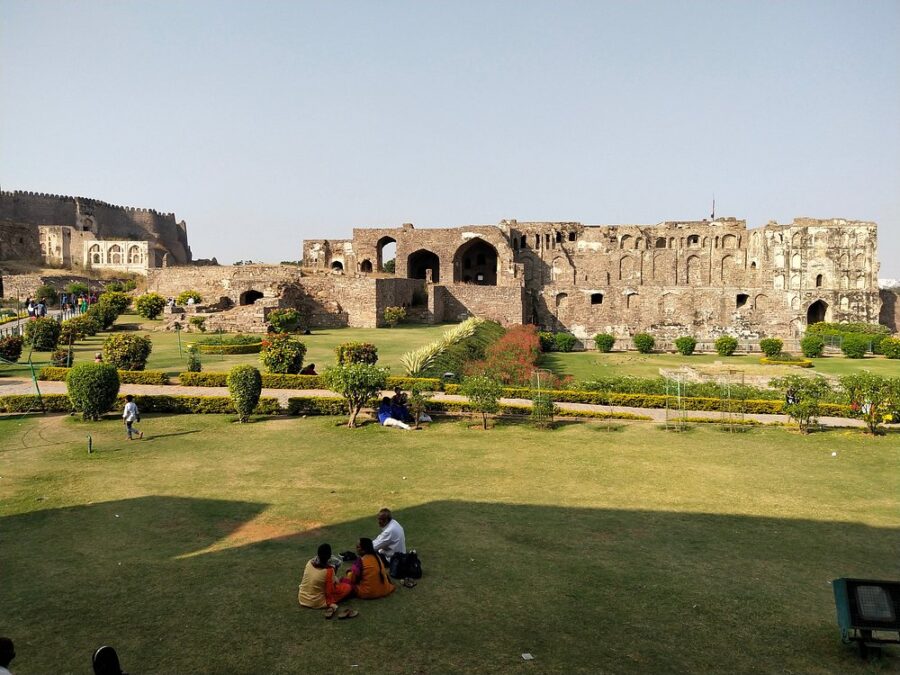
Golconda Fort
Table of Contents
History and Significance

The history of Golconda Fort is as rich and multi-layered as the Deccan soil upon which it stands. Originally a mud fort constructed by the Kakatiya dynasty, its true transformation into the formidable structure we see today began in 1518 with Sultan Quli Qutb-ul-Mulk, who established the Qutb Shahi dynasty. He took a small fortification and, through sheer will and strategic brilliance, began to fortify it into the grand capital of the Golconda Kingdom. For over 170 years, this fort was the beating heart of the Qutb Shahi Sultanate, a true power player in Southern India. And it’s no small feat, the way they expanded it, making it one of the most impregnable fortresses of its time. The Qutb Shahi kings, oh, they were quite the visionaries. Under their rule, Golconda Fort flourished, not just as a military stronghold but as a vibrant economic hub, particularly renowned for its diamond trade. You’ve heard of the Koh-i-Noor, right? Well, that legendary gem, along with many others, emerged from the Kollur Mine in the Golconda region, finding its way through the bazaars within these very walls. But alas, all good things come to an end. The siege of Golconda in 1687 by Mughal Emperor Aurangzeb marked the downfall of the Qutb Shahi dynasty and the end of Golconda’s golden era. Even today, the scars of that epic battle are visible, whispering tales of valor and loss.
Main Attractions and Activities
A visit to Golconda Fort is an immersive experience, a journey back in time. You absolutely must start at the Fateh Darwaza, the Victory Gate, and not just because it’s a magnificent arch; it’s where the fort’s famous eerie acoustics come alive. Stand at the entrance, clap your hands, and listen as the sound travels to the Bala Hissar Pavilion at the top, a remarkable acoustic feat designed for early warnings. It’s truly uncanny how that works! And as you ascend, you’ll pass through various bastions and gateways, each telling its own story, each a testament to the fort’s ingenious design. The inner fort holds a treasure trove of architectural wonders. There’s the grand durbar hall, the royal palaces, the stables, and even a mosque. While many structures are now ruined, their grandeur is still palpable. You can almost hear the echoes of royal decrees and bustling court life. Don’t miss the Toli Mosque, just outside the main complex, and of course, the magnificent Qutb Shahi Tombs, the resting place of the Qutb Shahis, a separate but essential part of the Golconda heritage. The Archaeological Survey of India has done a tremendous job preserving this UNESCO World Heritage Site, which is on the tentative list for formal recognition. It’s more than a monument; it’s a fortified citadel, a ruined city, a true testament to the Golconda Kingdom’s legacy.
Visitor Experience
My friends, a visit to Golconda Fort is more than just sightseeing; it’s an immersion into an architectural marvel and a historical narrative that will truly captivate your senses. The fort, a magnificent example of the Qutb Shahi dynasty’s architectural prowess, offers various points of interest that cater to different fascinations. For instance, the renowned acoustics at Fateh Darwaza, where a simple clap reverberates up to the Bala Hissar Pavilion, still sends shivers down my spine. It’s an ingenious security feature, a prime example of ancient engineering, and frankly, just plain cool. And the various palaces and structures within, even in their ruined state, hint at the opulent lives of the Qutb Shahi kings. You can almost feel the historical weight of this former capital of the Golconda Kingdom. The ambiance within the fort is unique. As you wander through the labyrinthine passages and ascend the numerous steps, you’re not just walking through stone structures; you’re tracing the footsteps of sultans, soldiers, and merchants from centuries past. The panoramic views of Hyderabad from the fort’s highest points are breathtaking, providing a stark contrast to the modern cityscape that surrounds this ancient citadel. And standing there, you can easily imagine the bustling activity of the diamond trade that once thrived in the Golconda region. It’s a place that truly encourages contemplation, a reminder of the fleeting nature of empires and the enduring legacy of human endeavor.
Tips for Visitors
So, you’re planning your trip to this magnificent fort? Excellent choice! To make your visit to Golconda Fort truly memorable, I’ve got a few pointers for you. First off, wear comfortable shoes; you’ll be doing a fair bit of walking and climbing. And I mean a fair bit. Believe me, your feet will thank you. The best time to visit is during the cooler months, from October to March, to avoid the scorching Hyderabad heat. I once went in May, and let’s just say I quickly learned my lesson about the Telangana sun! Also, arrive early in the morning to beat the crowds and enjoy the tranquil atmosphere before the fort gets too busy. This also allows you ample time to explore without feeling rushed. Consider hiring a local guide. While I’m usually one for self-discovery, a knowledgeable guide can truly bring the history of the Qutb Shahi dynasty and the significance of each bastion and gateway to life. They can point out the subtle nuances of the fort’s design, like the intricate water supply system, and share fascinating anecdotes that you wouldn’t find in a guidebook. And don’t forget to stay for the evening light and sound show, which beautifully narrates the fort’s history, from the Kakatiya dynasty’s mud fort beginnings to the siege of Golconda by Mughal Emperor Aurangzeb in 1687. It’s a spectacular way to end your exploration of this UNESCO World Heritage site, a true jewel of Southern India.
Accessibility and Facilities
Navigating Golconda Fort can be an adventure in itself, but it’s important to be aware of the accessibility aspects, especially for those with mobility challenges. As a sprawling fortified citadel with numerous steps and uneven paths, the fort, in its essence as a historical monument, presents certain physical limitations. While the lower sections and the immediate vicinity of the Fateh Darwaza are relatively accessible, reaching the higher points, like the Bala Hissar Pavilion or the various palace ruins, requires ascending a significant number of steps. I recall one particular climb where I felt every single step, but the view at the top was worth it. In terms of facilities, you’ll find public restrooms near the entrance and at various points within the complex. There are also vendors selling water and snacks, which you’ll appreciate, especially on a warm day. I’ve always found it prudent to carry my water bottle, though. The Archaeological Survey of India has done a commendable job in preserving the fort, but remember, it is a historical site, and modern conveniences are integrated thoughtfully to maintain its historical integrity. For visitors to Golconda Fort, the experience is largely about embracing the rugged beauty of a bygone era, a magnificent testament to the Golconda Kingdom and the enduring legacy of the Qutb Shahis.
Unique Features
What truly sets Golconda Fort apart from other historical sites in India, and indeed the world, are its astonishingly unique features, particularly the engineering marvel of its eerie acoustics. My first encounter with this phenomenon at the Fateh Darwaza, the Victory Gate, left me utterly spellbound. A simple clap near the entrance reverberates with such clarity and force that it’s distinctly audible at the Bala Hissar Pavilion, almost a kilometer uphill. This isn’t just a quirky feature; it was a sophisticated early warning system, demonstrating the advanced military engineering of the Qutb Shahi dynasty. It allowed the sultan’s guards to communicate impending dangers across the vast fortress, a testament to their ingenuity. And frankly, it’s just plain fun to try it yourself! Beyond the acoustic wonder, the intricate water supply system within the Golconda Fort is another testament to the ingenuity of the Qutb Shahi kings. They developed a sophisticated network of pipelines, reservoirs, and pumps that efficiently supplied water throughout the fortified citadel, even to the highest points of the inner fort. This was crucial for sustaining the large population within the capital of the Golconda Kingdom during sieges. And then there are the numerous bastions and gateways, each with its distinct architectural style and defensive purpose, making the circumference of the fort a true lesson in strategic design. It’s not just a collection of walls; it’s a living textbook on ancient warfare and urban planning, showcasing the rich history of the Golconda region.
Overall Impressions
My overall impression of Golconda Fort is one of profound awe mixed with a touch of melancholy for its lost grandeur. Standing within its massive walls, you can almost hear the echoes of the Qutb Shahi dynasty, the bustling markets, and the whispered secrets of the diamond trade that once made the Golconda Kingdom so renowned. The sheer scale of the fortification is mind-boggling; it’s not just a fort, but a ruined city, a testament to centuries of power and strategic brilliance. Even though much of the palace and other structures are now in ruins, their architectural footprints vividly tell the story of a bygone era. I particularly appreciate how the Archaeological Survey of India has worked to preserve this UNESCO World Heritage site, even if it’s currently on the tentative list. The atmosphere within the Golconda Fort is quite palpable, a tangible link to its rich past. You sense the history, from the early mud fort built by the Kakatiya dynasty to the strategic stronghold developed by Sultan Quli Qutb-ul-Mulk in 1518. And as you ascend towards the summit, the panoramic views of Hyderabad are simply breathtaking, offering a stark contrast between the ancient citadel and the modern metropolis. But my friends, don’t miss the Qutb Shahi Tombs just outside the main complex; they are magnificent structures in their own right and offer further insight into the lives of the Qutb Shahis. And of course, the thought of the Koh-i-Noor diamond originating from the Kollur Mine, somewhere in the Golconda region, adds another layer of mystique to the entire experience.
Pros and Cons
When considering a visit to Golconda Fort, there are certainly compelling pros that make it a must-see, but also a few cons that savvy travelers should be aware of. On the pro side, the sheer historical significance of this fortified citadel is immense; it was the capital of the Golconda Kingdom for centuries, a major hub for the diamond trade, and a formidable fortress that withstood the siege of Golconda by Mughal Emperor Aurangzeb in 1687 for months. The unique features, like the eerie acoustics at Fateh Darwaza, are truly captivating and a marvel of ancient engineering. And the architectural grandeur, even in its ruined state, offers a fascinating glimpse into the lives and legacy of the Qutb Shahi dynasty. You’ll gain a deeper appreciation for the rich history of Southern India. However, on the flip side, some aspects might detract from the experience for certain visitors. The sheer number of steps to reach the Bala Hissar Pavilion and other higher points can be quite demanding, especially for those with mobility issues or during the hotter months in Telangana. While there are some facilities, they are basic, and you won’t find a plethora of modern amenities within the fort itself. And while the Archaeological Survey of India has done a great job preserving the monument, some areas are still quite dilapidated, which, while historically authentic, might not appeal to everyone. But honestly, for anyone with a passion for history, architecture, or simply a good story, the pros of a visit to Golconda Fort far outweigh any minor inconveniences.
Location
Places to Stay Near Golconda Fort
Find and Book a Tour
Explore More Travel Guides
No reviews found! Be the first to review!